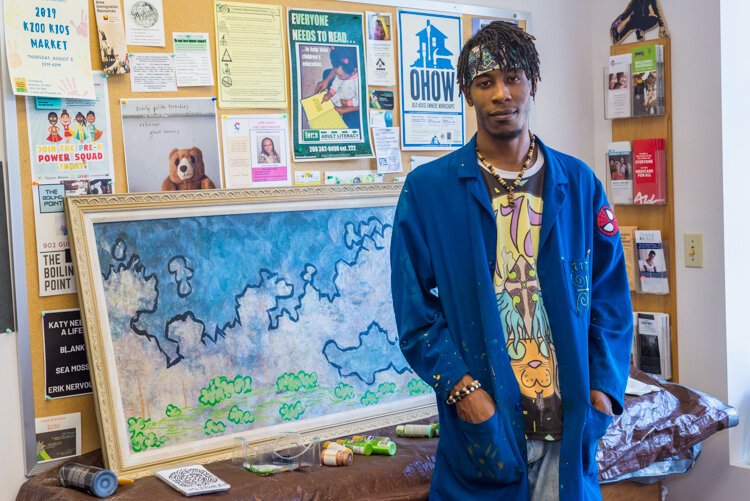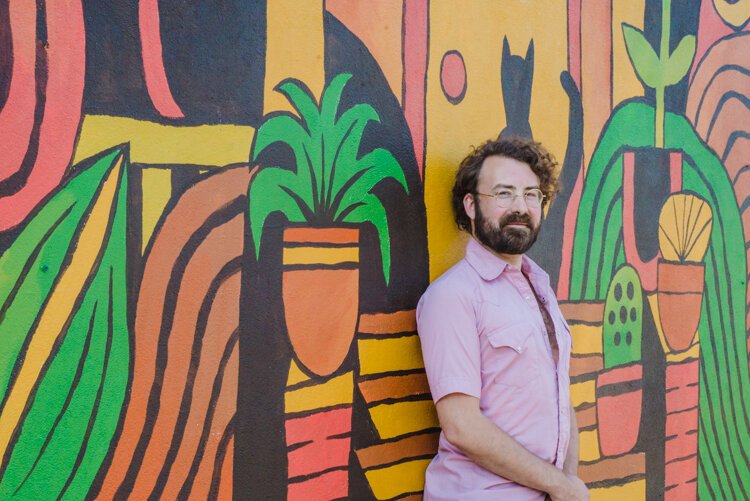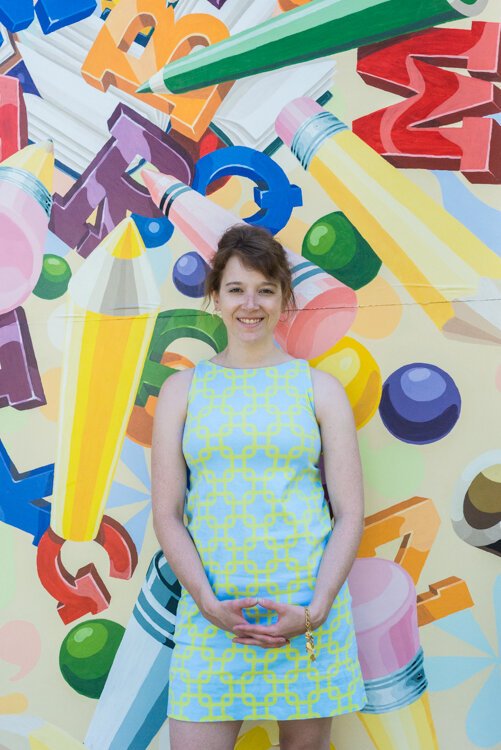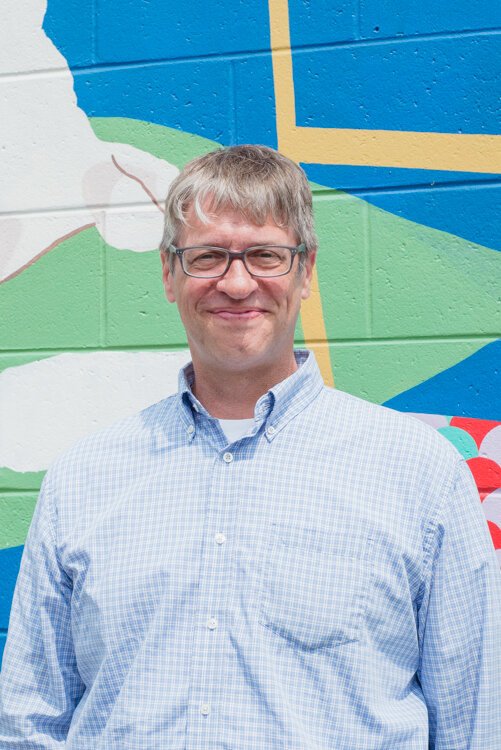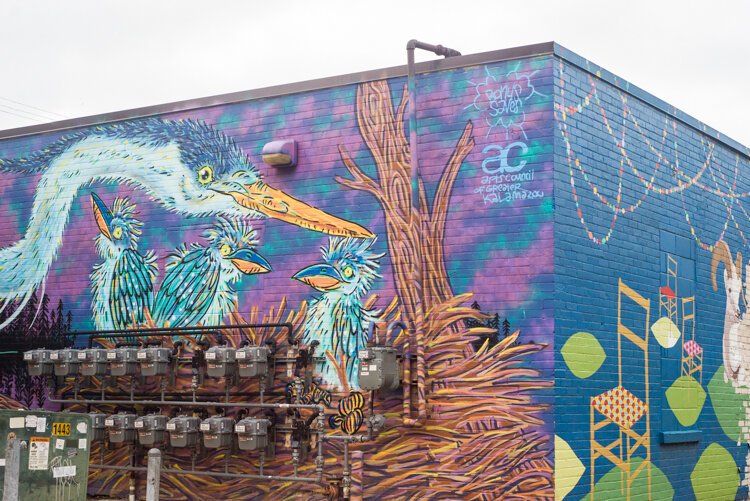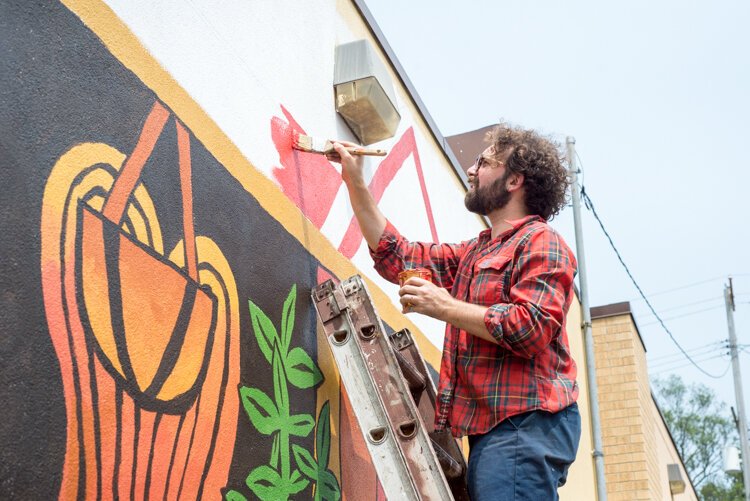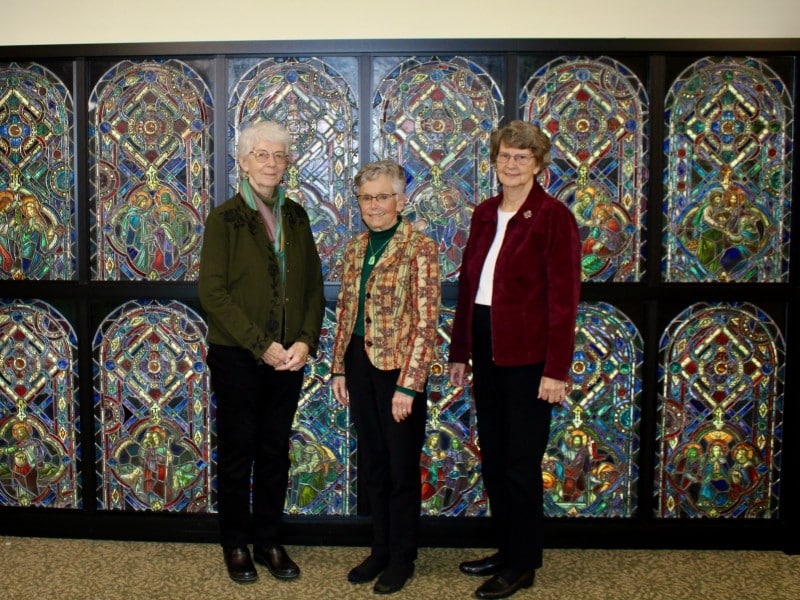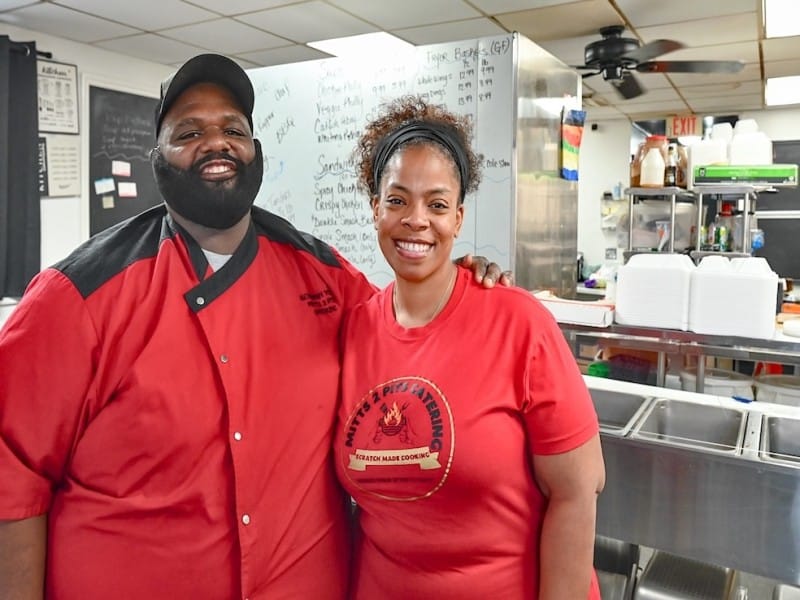‘Connecting business owners who have walls with artists who have paint’ in Kalamazoo’s Vine
In Vine, their collection of murals is growing because they believe art is for everyone. It's to be shared.
Editor’s note: This story is part of Southwest Michigan Second Wave’s On the Ground Vine Neighborhood series.
A gallery of murals is growing around the central corners business district in Vine, which is fast becoming the most concentrated space of public art in Kalamazoo.
The Vine neighborhood, known for its plentiful resident artists, is making a name for itself as a gallery of public art, thanks to a proactive neighborhood association and residents, such as Anna Lee Roeder and her husband Erik Vasilauskas. They believe strongly that public art enhances a sense of community and encourages imagination about what is possible.
“I’m really passionate about public art because it’s really accessible,” says Roeder, a Kalamazoo County Land Bank administrative assistant who has been heavily involved in other public art projects around Kalamazoo, including the Inside Out Project of black and white photographs displayed along Portage Street in Edison. “Public art is not confined to a gallery. It’s in people’s consciousness. You can affect people way beyond your knowing.”
In the last six years, five artists, all but one a resident or former Vine resident, have created and displayed six murals around the business buildings at Vine and South Westnedge, some painted directly on the walls and other on panels that are then hung.
The pieces represent diverse styles and palettes, and feature whimsical rams, birds, Vine scenes, a mandala, and a blue heron, to name a few. Artwork includes the first mural by Beverly Fitzpatrick, two murals by Bonus Saves (aka Patrick Herschberger), and the well-recognized Vine street map simulation by then resident Chafe Hensley.
Just this summer, two additional murals were finished. One, a Vine street scene designed and painted by Trevor Grabill, a printmaker and illustrator, was completed in July. A three-paneled mural of a colorful mandala made of letters and pencils created by Ellen Nelson, an illustrator, painter and muralist, was featured at the June Art Hop. A celebration of the two new murals will take place at the next Vine Art Hop on Aug. 2.
“People’s access to art increases the livability of a city,” says Nelson, who has a studio in the Park Trades Center. “They have things to be proud of in their community that reflect their values.”
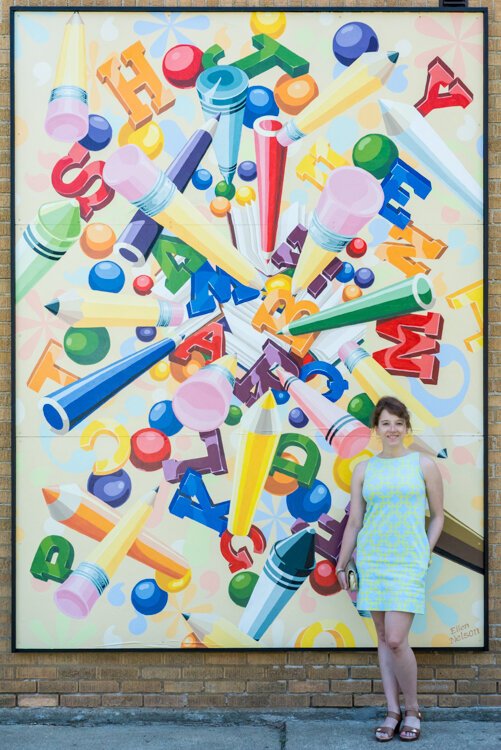
Steve Walsh, Vine Neighborhood Association Executive Director, says, “We’re very fortunate to have so many generous and dedicated artists who are willing to spend their time out in the elements and put their art up. The murals have profound ripple effects. They help beautify the area. People take pride in them, and they enjoy having access to the works.
“The majority of the art that has gone up is done by people in the neighborhood that people know.”
When Walsh first became executive director of the Vine Neighborhood Association 12 years ago, he says he looked for ways to actively involve the student energy that was then looked upon as a neighborhood detraction.
“The perception of the neighborhood then was so bleak. I felt that if we could embrace some of the things the students like to do, maybe they’ll feel a sense of ownership, advocacy, and stewardship,” Walsh says of the impetus behind the murals.
He adds that the dream to beautify the neighborhood through art has taken shape thanks to the support of organizations such as the Kalamazoo Neighborhood Housing Services, the Arts Council of Greater Kalamazoo, the City of Kalamazoo Neighborhood Engagement Fund, and some funds from the VNA.
In the six years since the mural-museum has been growing, Walsh says there has been only one issue of defacement — on Fitzpatrick’s ram mural — and that was quickly fixed.
“Where I come from, there’s just an understanding that you don’t just paint over other people’s works,” says Walsh, referring to an unwritten code among graffiti artists. Walsh says he was also aware before the VNA began actively seeking artists that “if we don’t get stuff up on these walls, we’re going to get stuff up on these walls.” Stuff they don’t want to see there.
With the two recent murals, the VNA has had many neighborhood artists approach him about wanting to participate, including Alexander Ladd, an artist recently featured at the July Vine Art Hop. And if funding becomes available there are more spaces in the neighborhood where artwork could go up.
“The more we put up, the better they are received,” says Walsh.
Creating murals in public invites public participation
In a neighborhood where many have their own informal front porch art galleries a collection of murals is a natural extension of that love for art, says Grabill. The concept for Grabill’s mural was inspired by resident feedback to a community engagement session last August facilitated by Vasilauskas in which ideas for what makes Vine special were solicited.
“The things that people were most excited about weren’t monumental, they were just beautiful spots in the neighborhood,” says Grabill.
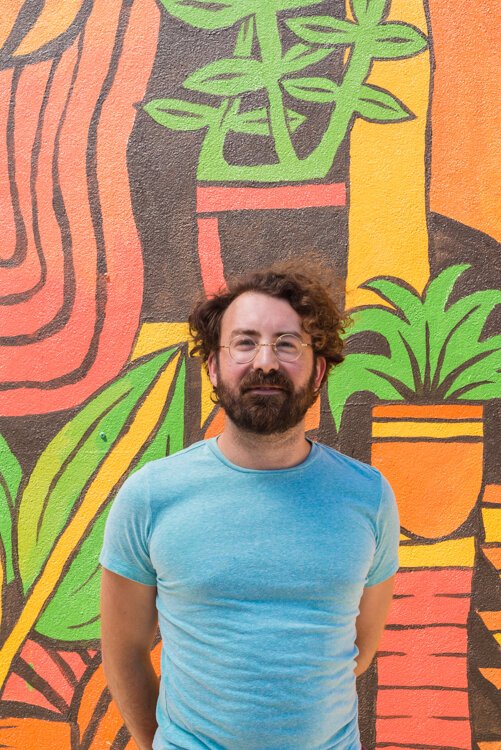
Not only does finished public art add vibrancy to the space, but the process of creating the art adds an extra dimension for the artist, as Grabill discovered when he was preparing and painting his mural.
“The idea of art being consumed outside of a gallery space has always excited me,” says Grabill. As the VNA mural was his first, he says he was surprised by the amount of interest it drew as he was painting it.
“The act of making it in public was exciting. People would stop by and tell you what they liked and what they didn’t like and how they thought you could do it differently,” says Grabill. “It was really fun. I like talking to people. It was funny and weird. It was a conversation.”
Now that he’s finished his first mural, Grabill says he’s applying to other mural residencies. “We curate really carefully in our lives,” he says, referring to social media. “Public art in public spaces brings a lot of energy to who we are and how we are in the world.”
Another testament to the power of public art is the number of people who stop by and take their photos near it, says Walsh, an event he sees frequently.
“As a studio artist, creating is usually a solitary practice,” says Grabill. “There’s something really valuable and precious about working within your community.”
The Kalamazoo Public Arts Initiative: A vision in progress
Roeder and Vasilauskas, both artists themselves, are no strangers to public art. They recently finished a massive and colorful re-painting of Kik Pool. They’ve also visited public art spots around the world, as well as participated in the creation of murals worldwide. Roeder has also primed, designed, and painted the Oak Street garden shed in Vine.
“We saw public art in action this season when we painted over at the Kik Pool building,” says Roeder. “The peeling paint looked off-putting. There’s a lot of kids that play in the park and who live right across the street. I found it interesting to see how they interacted before, during, and after the process. The artwork really breathed new life into that space. People were happy to see that effort put into that environment.”
“It spreads the idea that others value the infrastructure in your community,” Vasilauskas says.
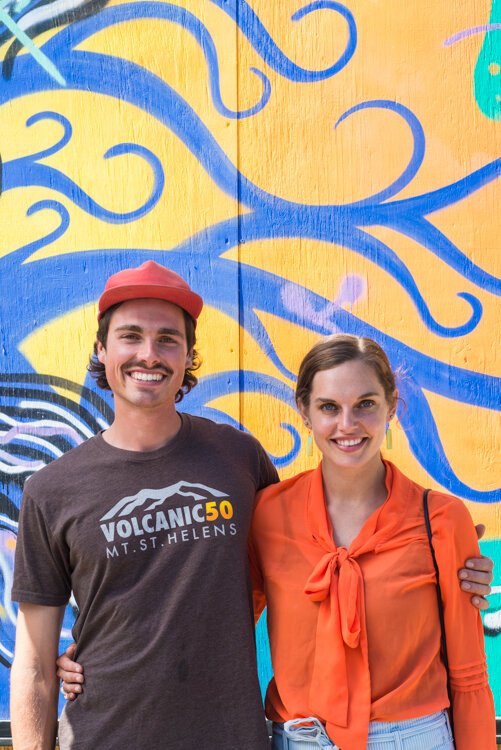
“Projects like this are important,” says Nelson. “When you are creating art, you have to constantly remind yourself, it’s not about me. Art is the greater force that flows through us. It’s not just for one person to have. It’s for everyone. It’s to be shared.”
“The real power of public art is that it gets other people to see it and consider making it,” says Grabill. “It chips away at that distinction between those who make art and those who don’t.”
As for the two recent Vine murals, they are already generating a buzz, says Walsh, who has received several calls from interested artists. Grabill says he has heard a lot of people say, “How can I do a mural, too? I’ve heard a lot of people reaching out,” says Grabill. “I would love to see other people doing public art, too.”
“One good mural begets another,” says Vasilauskas, a U.S. Postal Carrier who credits the Kalamazoo Institute of Arts Kirk Newman School with growing him as an artist over the last four years.
“We were fortunate to create murals in very public spaces,” says Nelson, who adds she was excited to work on not only the painting, but also the design part of the project. “It’s wonderful to give back. That’s what makes it special. It’s like a gift to everyone.”
In addition to the more than 30,000 cars that pass the Vine and South Westnedge corner each day, there is plenty of foot traffic. And Nelson’s mural happens to be on a very visible corner where cars stopped at the light can linger. With its literacy-oriented theme, the mural also ties together Read and Write Kalamazoo, on whose wall it is hung, the Kalamazoo Math and Science Center across the street, and El Sol Elementary School, the Spanish immersion magnet school down the street.
“I’m really excited to see more artists featured,” says Roeder. “We’re really fortunate to have a neighborhood association that champions these types of projects wholeheartedly. That makes such a huge difference because they own this building. And it really speaks to their commitment to the art.”
Sarah Ruggles, VNA Board Chair, helped apply for funding and participated in coordinating the recent two murals.
Spurred on by the Vine and Kalamazoo area successes, Roeder and Vasilauskas are in the process of developing a citywide project they call the Kalamazoo Public Arts Initiative, hoping that the murals that are populating the center of Vine will radiate outward to other parts of the neighborhood and into the city, anywhere there is a blighted building or peeling paint.
Roeder and Vasilauskas don’t think there will ever be too many public artists because every fence, shed, wall and mailbox is a potential canvas.
The couple believes in “connecting business owners who have walls with artists who have paint,” Roeder says.
“If maintenance is needed, create art,” says Vasilauskas. “Anyone who needs a paint job should consider creating art.”
“Sometimes it’s not about waiting for a call,” says Roeder. “I would encourage anybody who wants to do a mural to reach out for opportunities.”
Or if it’s a project in their own yard: “Just start painting.”

